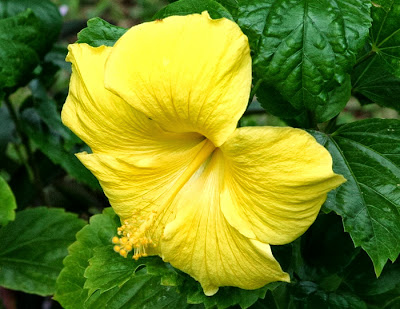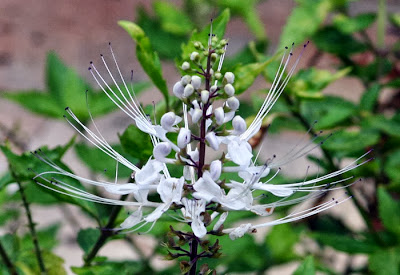Welcome!
Welcome to my zone 9a habitat garden near Houston, Texas.
Wednesday, October 30, 2013
Note to my readers
To those of you who may have noticed my recent blog silence and wondered about it, the truth is that I have been quite sick. A bacterial infection has flattened me and made it impossible for me to do much of anything, including blogging. I hope to be feeling better soon and back to my normal activities. Meantime, thank you for your patience.
Wednesday, October 23, 2013
Thursday, October 17, 2013
Bumblebees
(Re-posted from The Nature of Things.)
Bumblebees are one of the few members of the insect world that most people actually like. They are a major contingent of the community of pollinators that inhabit my garden, and I find them to be good neighbors. I've worked in and around bees for many years and I've never been stung. Queen and worker bumblebees do have stingers and the capacity to sting, but they are very reluctant to use them. I find that if you leave them alone, they will leave you alone.
Bumblebees are large, hairy insects with a lazy buzz and a clumsy-looking, bumbling flight. Most of them, at least in our area, are black and yellow. They are members of the genus Bombus in the familyApidae. They are social insects that are found mainly in northern temperate regions. There are a few that are native to South America and some that are naturalized in New Zealand.
They can range much farther north than honeybees, because they are able to regulate their body temperature. In fact, there are colonies that can be found on Ellesmere Island in northern Canada where it gets quite cold. There have been schemes to introduce bumblebees to other parts of the world where they are not native, but usually such schemes turn out to have unintended consequences (Think about the House Sparrow in North America.) and are not a good idea.
Bumblebees start fresh with a new colony each spring. A queen that had mated the previous year is the mother of the colony. She first produces worker bees that are all female. Eventually, she produces drones (males) and, finally, new queens. At the end of the colony's life, only the new queens survive to start things off again next year.
The bumblebee colony is much smaller than that of the honeybee. A mature colony may contain only 50 individuals.
There is a quote attributed to Albert Einstein, which actually seems to be apocryphal, that said that without bees to pollinate our food crops, humans would die out within four years. The quote may be apocryphal but the information is probably not far off the mark. If bees died out, it seems certain that life as we know it would cease to exist within a short period of time. There would be much less to eat and it is possible that the human race could die out. At the very least, it is likely that it would be greatly reduced in number.
Bees of all kinds are in trouble today, primarily because of the overuse and misuse of chemical pesticides, loss of habitat, and the effects of global warming. The status of the bumblebee is more secure than the honeybee, but it, too suffers from these maladies. I make sure that no chemical pesticides are used in my garden and that there are plenty of flowers there to provide pollen and nectar. The adults feed on nectar. They use pollen to nourish their young.
Bumblebees are fascinating critters that make the backyard more interesting. If you are lucky enough to have them in your yard, I hope you will treasure them as I treasure mine.
Bumblebee on Mexican firebush (Hamelia patens).
Bumblebees are one of the few members of the insect world that most people actually like. They are a major contingent of the community of pollinators that inhabit my garden, and I find them to be good neighbors. I've worked in and around bees for many years and I've never been stung. Queen and worker bumblebees do have stingers and the capacity to sting, but they are very reluctant to use them. I find that if you leave them alone, they will leave you alone.
Bumblebees are large, hairy insects with a lazy buzz and a clumsy-looking, bumbling flight. Most of them, at least in our area, are black and yellow. They are members of the genus Bombus in the familyApidae. They are social insects that are found mainly in northern temperate regions. There are a few that are native to South America and some that are naturalized in New Zealand.
They can range much farther north than honeybees, because they are able to regulate their body temperature. In fact, there are colonies that can be found on Ellesmere Island in northern Canada where it gets quite cold. There have been schemes to introduce bumblebees to other parts of the world where they are not native, but usually such schemes turn out to have unintended consequences (Think about the House Sparrow in North America.) and are not a good idea.
Busy bumblebee on a salvia blossom.
Bumblebees start fresh with a new colony each spring. A queen that had mated the previous year is the mother of the colony. She first produces worker bees that are all female. Eventually, she produces drones (males) and, finally, new queens. At the end of the colony's life, only the new queens survive to start things off again next year.
The bumblebee colony is much smaller than that of the honeybee. A mature colony may contain only 50 individuals.
There is a quote attributed to Albert Einstein, which actually seems to be apocryphal, that said that without bees to pollinate our food crops, humans would die out within four years. The quote may be apocryphal but the information is probably not far off the mark. If bees died out, it seems certain that life as we know it would cease to exist within a short period of time. There would be much less to eat and it is possible that the human race could die out. At the very least, it is likely that it would be greatly reduced in number.
Bees of all kinds are in trouble today, primarily because of the overuse and misuse of chemical pesticides, loss of habitat, and the effects of global warming. The status of the bumblebee is more secure than the honeybee, but it, too suffers from these maladies. I make sure that no chemical pesticides are used in my garden and that there are plenty of flowers there to provide pollen and nectar. The adults feed on nectar. They use pollen to nourish their young.
Bumblebees are fascinating critters that make the backyard more interesting. If you are lucky enough to have them in your yard, I hope you will treasure them as I treasure mine.
The flight of the bumblebee.
Wednesday, October 16, 2013
Tuesday, October 15, 2013
Garden Bloggers' Bloom Day - October 2013
Welcome to my October garden which is continuing its slow decline into winter. Of course, winters here are not much to write home about usually. Even so, comparatively mild though it may be, it's a time of rest and refreshment for the garden and, to some extent, for the gardener as well. An event to look forward to.
There are still plenty of blooms in the garden this month, but very few that are new.
The goldenrod is just beginning to bloom.
The fall asters have not done very well, but they are giving me a few blossoms.
Autumn just wouldn't be autumn without a pot of chrysanthemums blooming by the front door.
Other than these October additions, my blooms are pretty much the same old same old.
The spring-blooming crossvine puts out a few autumn blossoms, too. I didn't notice the little anole on the left until I uploaded the picture.
There are still plenty of blooms in the garden this month, but very few that are new.
The goldenrod is just beginning to bloom.
The fall asters have not done very well, but they are giving me a few blossoms.
Autumn just wouldn't be autumn without a pot of chrysanthemums blooming by the front door.
Other than these October additions, my blooms are pretty much the same old same old.
Shrimp plant and 'Mystic Spires' salvia bloom together.
After a long hiatus, the bush marigold is beginning to bloom again.
Blackfoot daisies.
Lantana
And more lantana.
Turk's Cap.
Species canna.
A few zinnias are still blooming.
The spring-blooming crossvine puts out a few autumn blossoms, too. I didn't notice the little anole on the left until I uploaded the picture.
Mexican firebush (Hamelia patens).
Butterfly ginger.
Yellowbells (Tecoma stans).
Cypress vine.
Sunny yellow hibiscus.
White cat's whiskers blossom.
Ruellia: 'Chi Chi' (left) and 'Katie' (right).
Summer-blooming wax begonia extending its bloom into autumn.
Purslane.
Wedelia.
Autumn sage.
'Tropicanna.'
'Bleeding Heart' clerodendrum that hasn't quite started "bleeding" yet.
Yellow cestrum.
Cape honeysuckle.
Cape (Blue) Plumbago.
'Coral Nymph' salvia.
David Austin rose 'Molineux.'
So, there you have it - my oldies but goodies edition for October Bloom Day.
Don't forget to visit our hostess Carol at May Dreams Gardens for a list of all the bloggers participating in this month's Bloom Day.
Happy Bloom Day and happy gardening!
Friday, October 11, 2013
This week in the garden - #80
It's been a lovely week in the garden, for the most part. The weather has been pleasant, at least until today when the heat and humidity returned a bit. I've managed to get several chores done, but I've also managed to spend time just sitting in or walking through the garden to enjoy this time of year.
The cat whiskers plants have been a disappointment this year, but now the white one is trying to make up for lost time. The purple variety though is still lagging.
Jatropha continues to put out a few blooms.
The red yucca puts up a long bloom spike in spring and then starts blooming beginning at the bottom of the spike. All summer long, the rows of blooms continue to open in turn, traveling up the spike. Now, the bloom cycle has reached the very top of the spike and is beginning to open these final blossoms. These flowers must be very rich in nectar because every passing hummingbird stops to sip from them.
The 'Mystic Spires' salvia is a great favorite with bumblebees.
This is one of the double-blossomed hybrid daturas that I raised from seeds. It has been a very prolific bloomer.
'Chi Chi' ruellia loves autumn.
And so do the butterfly gingers. They've been in bloom for weeks now and show no signs of slowing down.
Some of the milk and wine lilies have started putting out some blooms once again.
As the weather warmed toward the end of the week, I started seeing green anoles again. There are lots of baby anoles around and this is one of them. You can't really judge size from this picture, but I would say his body was about two inches long, his tail perhaps four inches in length. Many of the babies that I'm seeing are much smaller than this.
As we ease toward mid-autumn, the leaves are yellowing more and more and falling from the trees. The setting sun has traveled about halfway across my yard since late summer. It is now much farther to the south and it drops below the trees on my western horizon much earlier. Not so long ago, it was still light at 8:30 P.M., but now by 7:30, all that's left is the faint afterglow of the setting sun. Winter, with its short days, is coming and gets a little closer with every sunset.
Subscribe to:
Posts (Atom)


















































